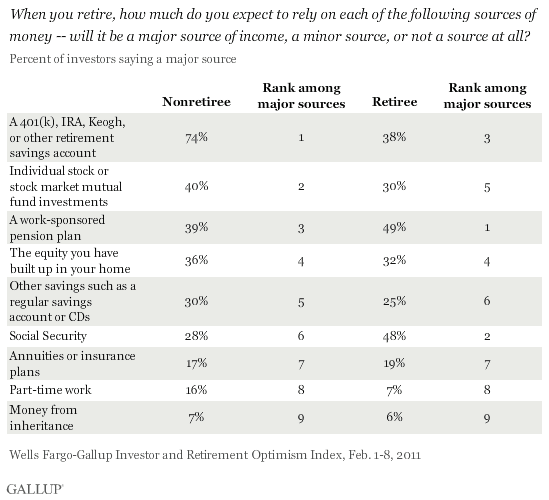PRINCETON, NJ -- Investors who have yet to retire look to retirement accounts, such as 401(k), IRA, and Keogh accounts (74%), and stocks or stock market mutual fund investments (40%) as major funding sources when they retire, according to the latest Wells Fargo/Gallup Investor and Retirement Optimism Index survey. Social Security ranks sixth at 28%. In sharp contrast, current retirees say they depend on pension plans (49%) and Social Security (48%) as their top sources of income; retirement accounts rank third at 38%.

The Wells-Fargo/Gallup Investor and Retirement Optimism Index defines investors as those having $10,000 or more of investable assets.
While the top six major retirement funding sources are the same for those yet to retire and retirees, nonretirees expect to depend far more on their personal resources than do current retirees. Nothing illustrates this better than the sharp difference in how these two groups rank Social Security. These rankings also reflect the shift among employers away from pensions to tax-favored retirement accounts.
It seems somewhat surprising, given the continued depressed housing market and falling home prices, that 36% of those yet to retire look to the equity in their home as a major source of retirement funding -- similar to the 32% of current retirees.
Investors Rank Investments and Health as Top Factors Affecting Retirement Timeline
About three in four investors say the major factor that will determine when they are financially able to retire is the value of their investments. This reflects nonretired investors' reliance on their own resources to fund their retirement.
Two in three investors rank their personal health and the cost of healthcare as key determinants of their financial ability to retire. This is likely one of the reasons why so many Americans continue to worry about the full implications of the healthcare reform legislation passed last year.
The status of their pensions ranks fifth, at 53%, among the factors driving when investors will be financially able to retire. While fewer Americans have pensions, those who do have them seem to see their pension provisions as a key determinant.

National issues trail many personal concerns in investors' reports of what factors will have a major impact on when they will be financially able to retire. Roughly half of investors say inflation (59%), the solvency of Social Security (50%), and energy prices (48%) will have a major impact on their ability to retire. Workplace and job conditions rank eighth, at 43%. Investors are least concerned about interest rates (37%) and the value of their businesses (37%) and homes (36%).
Investors' Saving Habits Align With Retirement Expectations
Nonretired investors' behaviors seem aligned with their retirement funding expectations:
-
73% have a 401(k), and 63% have contributed to theirs in the past 12 months
-
62% have an IRA, and 37% have contributed to theirs in the past 12 months
-
45% have a pension
Additionally, 73% have put away more (31%) or the same amount (42%) of money for retirement over the past 12 months as they did the prior year.
About half of retirees (58%) and nonretirees (48%) say they have a great deal or quite a lot of confidence that they will have the money they need to live comfortably throughout their retirement. And, while 62% of retirees are similarly confident they will be able to maintain their lifestyle in retirement without working, fewer nonretirees feel this way (40%).
Implications
In one sense, these findings are encouraging. Many American investors who have yet to retire recognize the need to provide their own funding for retirement and are acting to make that happen. Further, investors are hopeful about retirement, with 72% of retirees and 62% of those yet to retire believing retirement is/will be a fulfilling phase in their lives.
On the other hand, less than half of investors -- who represent roughly the top third of Americans in terms of investable assets -- are confident in their ability to achieve a comfortable retirement or maintain their lifestyle without working in retirement. This lack of confidence concerning retirement among this more financially secure group of Americans does not bode well for those who are not as well off. Maybe that is why retirement remains high on Americans' worry list.
Survey Methods
Results for the Wells Fargo/Gallup Investor and Retirement Optimism Index survey are based on telephone interviews conducted as part of Gallup Daily tracking, with a random sample of 1,000 or more respondents, aged 18 and older, living in all U.S. states and the District of Columbia, selected using random-digit-dial sampling from Feb. 1-8, 2011.
For results based on this sample of investors, one can say with 95% confidence that the maximum margin of sampling error is ±4 percentage points.
Interviews are conducted with respondents on landline telephones and cellular phones, with interviews conducted in Spanish for respondents who are primarily Spanish-speaking. Each daily sample includes a minimum quota of 200 cell phone respondents and 800 landline respondents, with additional minimum quotas among landline respondents for gender within region. Landline respondents are chosen at random within each household on the basis of which member had the most recent birthday.
Samples are weighted by gender, age, race, Hispanic ethnicity, education, region, adults in the household, cell phone-only status, cell phone-mostly status, and phone lines. Demographic weighting targets are based on the March 2010 Current Population Survey figures for the aged 18 and older non-institutionalized population living in U.S. telephone households. All reported margins of sampling error include the computed design effects for weighting and sample design.
In addition to sampling error, question wording and practical difficulties in conducting surveys can introduce error or bias into the findings of public opinion polls.
For more details on Gallup's polling methodology, visit https://www.gallup.com/.
